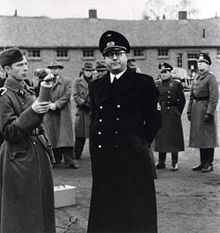Vlaamsch Nationaal Verbond
Flemish National Union Vlaamsch Nationaal Verbond | |
|---|---|
| Political position | Far-right[5] |
| French-speaking counterpart | Rexist Party (1936–1937)[6] |
| Slogan | "Authority, discipline, and Dietsland" |
| Party flag | |
 | |
The Vlaamsch Nationaal Verbond (Dutch for "Flemish National Union" or "Flemish National League"), widely known by its acronym VNV, was a Flemish nationalist political party active in Belgium between 1933 and 1945.[7] It became the leading force of political collaboration in Flanders during the German occupation of Belgium in World War II. Authoritarian by inclination, the party advocated the creation of a "Greater Netherlands" (Dietsland) combining Flanders and the Netherlands.
Origins
The Vlaamsch Nationaal Verbond (VNV) was founded on 8 October 1933. Its origins were in the long-established
It shared many ideological elements with Verdinaso, a rival party founded two years earlier but slightly less radical. Unlike Verdinaso, the VNV took part in elections and included a relatively moderate wing.[11] Initially, it also differed from Verdinaso in not being an anti-Semitic movement. Still, it increasingly embraced anti-Semitic elements after 1935, out of political calculation rather than ideological conviction.[12]
In the 1936 Belgian general election, the VNV received 13.6% of the Flemish vote, corresponding to 7.1% nationwide. After the election, in which the far-right nationalist and Catholic Rexist Party also performed strongly, the two parties concluded an alliance intended to create a corporatist Belgian state with great autonomy for Flanders. The VNV revoked this agreement after just one year.[6] In the 1939 elections, the VNV moderately increased its share of the Flemish vote to 15% (8.4% nationally) while the Rexist vote collapsed.[11]
Despite cooperating with the Flemish section of the mainstream centre-right Catholic Party on the local level, De Clercq realised that his movement would not be able to take power by democratic means. Instead, he contacted Nazi Germany, hoping his project could be realised with German help. He contacted the Abwehr, Germany's military intelligence service, informing them that a part of the Belgian military supported his movement and could be controlled by him if Germany declared war. The Belgian state security gained knowledge of these contacts and arrested some VNV supporters.[11]
Collaboration

When Nazi Germany invaded Belgium in 1940, De Clercq immediately chose to orient the VNV towards
Declercq died suddenly in October 1942 and was succeeded by Hendrik Elias, a member of the more moderate side. Elias continued collaborating with the Nazis but tried to come to terms with the military government to prevent the installation of a civilian government composed of Nazis. Elias failed, as Hitler installed the new body and declared the annexation of Flanders by Germany in 1944; seven weeks later, Belgium was liberated by the Allies. The VNV was outlawed after the liberation of Belgium. Elias fled to Germany but was tried after the war and imprisoned until 1959.
Electoral performance
| Election | Votes | Seats | Position | Government | ||
|---|---|---|---|---|---|---|
| # | % | # | ± | |||
| 1936 | 166,737 | 7.06 | 16 / 202
|
|||
| 1939 | 164,253 | 8.40 | 17 / 202
|
|||
Footnotes
- ISBN 978-90-5487-517-8.
- ^ VLAAMS NATIONAAL VERBOND (VNV). www.belgiumwwii.be.
- ^ DBNL. "Maurice de Wilde, België in de Tweede Wereldoorlog. Deel 3 · dbnl". DBNL (in Dutch). Retrieved 2021-07-03.
- ^
ISBN 9781483305394. Retrieved 9 September 2020.
... fascist Italy ... developed a state structure known as the corporate state with the ruling party acting as a mediator between 'corporations' making up the body of the nation. Similar designs were quite popular elsewhere in the 1930s. The most prominent examples were Estado Novo in Portugal (1932–1968) and Brazil (1937–1945), the Austrian Standestaat (1933–1938), and authoritarian experiments in Estonia, Romania, and some other countries of East and East-Central Europe,
- ^ Witte, Els (2009). Political History of Belgium, from 1830 onwards. ASP. p. 157.
- ^ a b Capoccia, Giovanni (2005). Defending Democracy: Reactions to Extremism in Interwar Europe. Johns Hopkins University Press. p. 114.
- ^ Kinderen van de collaboratie. Ervaringen en getuigenissen van nakomelingen van collaborateurs in de Tweede Wereldoorlog. University of Ghent, 2010, Master thesis history
- ^ Ishiyama and Brening, p. 1123
- ^ B. De Wever, Vlaams Nationaal Verbond (VNV) at Belgium-WWII
- ^ Payne, Stanley G. (1995). A History of Fascism, 1914–1945. University of Wisconsin Press. p. 424.
- ^ a b c De Wever, Bruno (2006). "Belgium". World Fascism: A Historical Encyclopedia. Vol. 1. ABC-CLIO. p. 86.
- ^ Kallis, Aristotle (2009). Genocide and Fascism: The Eliminationist Drive in Fascist Europe. Routledge. p. 278.
- ^ Rees (1991). Biographical Dictionary of the Extreme Right. p. 179.
- ^ Kallis, Aristotle (2009). Genocide and Fascism: The Eliminationist Drive in Fascist Europe. Routledge. p. 280.
References
- Clough, Shepard B. (1946) [1945]. "IX: The Flemish Movement". In Goris, Jan-Albert (ed.). Belgium. The United Nations. Berkeley, CA: University of California Press.
- De Wever, Bruno (1994). Greep naar de Macht: Vlaams-nationalisme en Nieuwe orde, het VNV 1933-1945. Tielt: Lannoo. ISBN 902092267X.
- Ishiyama, John T.; Breuning, Marijke (1998). Ethnopolitics in the New Europe. Lynne Rienner Publishers. ISBN 978-1555876104.
- ISBN 978-0130893017.
